Liverpool Street station
In the build-up to the Second World War, the station served as the entry point for thousands of child refugees arriving in London as part of the Kindertransport rescue mission.[12][13] The original intention was to build a terminus which reached as far south as the road London Wall, and which would be as tall as the Broad Street station which was being planned at the same time, however the city authorities did not permit the more southerly location.The station was planned to be around 630 by 200 ft (192 by 61 m) in area, with its main façade onto Liverpool Street and an additional entrance on Bishopsgate-Street (now called Bishopsgate and forming part of the A10).[10] Local trains began serving the partially completed station from 2 October 1874,[13] and it was fully opened on 1 November 1875,[24] at a final cost of over £2 million.[30] The main station was extended about 230 ft (70 m) eastwards; additional shops and offices were constructed east of the new train shed up to the parish boundary with Bishopsgate-Street Without.[35] Additional civil works included three iron bridges carrying road traffic over the railway on Skinner, Primrose and Worship Streets.[40] By the turn of the 20th century, Liverpool Street had one of the most extensive suburban rail services in London, including branches to Southend Victoria and Woodford, and was one of the busiest in the world.[41] Operation Turkenkreuz, the initial First World War biplane air raid on London, took place on 13 June 1917, when 20 Gotha G.IV bombers attacked the capital.[46] Over 1,000 GER employees who died during the war were honoured on a large marble memorial installed in the booking hall, unveiled on 22 June 1922 by Sir Henry Wilson.[27] The station also has a plaque commemorating mariner Charles Fryatt who was executed in 1916 for ramming a German U-boat with the GER steamer SS Brussels.[41] They considered high-powered and high-tractive steam locomotives including the GER Class A55 as a possible alternative, but these were rejected because of high track loadings.The boxes were: Thousands of Jewish refugee children arrived at Liverpool Street in the late 1930s as part of the Kindertransport rescue mission to save them in the run up to the Second World War.The Für Das Kind Kindertransport Memorial sculpture by artist Flor Kent was installed at the station in September 2003 commemorating this event.It consisted of a specialised glass case with original objects and a bronze sculpture of a girl, a direct descendant of a child rescued by Nicholas Winton, who unveiled the work.[60] During the war, the station's structure sustained damage from a nearby bomb, particularly the Gothic tower at the main entrance on Liverpool Street and its glass roof.[61] As a precautionary measure the large and weighty West Side hanging clock was brought down to platform level and served as an enquiry office for the duration of the war.[62] After the formation of the London Passenger Transport Board in 1933, work to electrify the line from Liverpool Street to Shenfield began in association with the LNER.[92] In advance of the full opening of the Elizabeth line, precursor operator TfL Rail took over from Greater Anglia the Liverpool Street-Shenfield stopping "metro" service from 2015.[93] At the same time, services on the Lea Valley Lines out of Liverpool Street to Enfield Town, Cheshunt (via Seven Sisters) and Chingford transferred to London Overground.[8] A new ticket hall with step-free access opened next to the Broadgate development, with links to the existing Underground station, and a pedestrian link via the new platforms to the ticket hall of Moorgate, providing direct access to London Underground's Northern line and the National Rail Northern City Line at Moorgate.[102] Trains on the central section of the Elizabeth line run west towards Paddington and east to Abbey Wood in south-east London.[118] Liverpool Street had been designed to integrate with the expanding London Underground network, and served as a new terminus for the Metropolitan Railway (MR) which extended east from Moorgate.Some sources suggest that the local people forced entry, others that staff decided to open the gates to everyone without asking for tickets, something which would have been technically illegal.[127] During the 7 July 2005 terrorist attacks on London, a bomb was exploded aboard an Underground train that had departed Liverpool Street toward Aldgate.The study is to establish how the original cast-iron lining sections, which are similar to those used for many miles of railway under London, resist possible deformation and soil movement caused by the developments.[149][150] H. G. Wells's 1898 novel The War of The Worlds included a chaotic rush to board trains at Liverpool Street as the Martian machines overran military defences in the West End.The walls and beams like beryl shone; And dappled light the platforms strewed With yellow foliage of the dawn That withered by the porch of day's divan.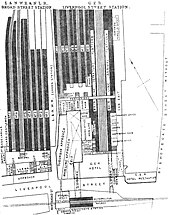

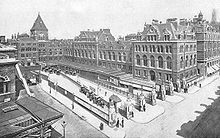
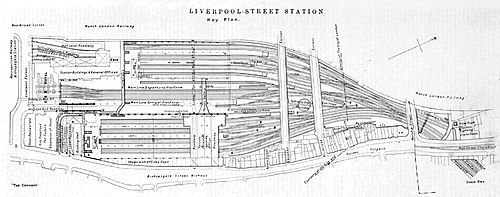

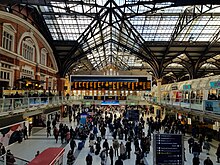

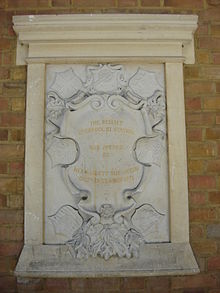


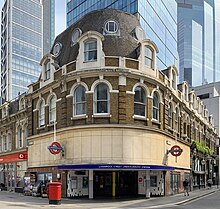
Liverpool Lime StreetBishopsgateCity of LondonNetwork RailDfT categoryFenchurch StreetMoorgateGreat Eastern RailwayLondon & North Eastern RailwayListedCoordinatescentral London railway terminusLondon UndergroundBishopsgate WithoutWest Anglia Main LineCambridgeGreat Eastern Main LineNorwichEast of EnglandWeaver lineLondon OvergroundStansted ExpressStansted AirportBishopsgate stationFirst World WarSecond World WarKindertransport1993 Bishopsgate bombing7 July 2005 bombingElizabeth lineCrossrailUndergroundMetropolitan RailwayCentralCircleHammersmith & CityMetropolitan linesfare zone 1CheshuntTheobalds GroveEnfield TownTurkey StreetRomfordBush Hill ParkSouthburyEmerson ParkUpminsterEdmonton GreenSilver StreetChingfordWhite Hart LaneHighams ParkWatford JunctionBruce GroveWood StreetWatfordSeven SistersWalthamstow CentralHigh StreetHarringayBlackhorse RoadWalthamstow Queen's RoadBusheyGreen LanesCarpenders ParkCrouch HillSouth TottenhamSt. JamesLeyton Midland RoadHatch EndStamford HillStreetLeytonstoneHeadstone LaneHollowayStoke NewingtonClaptonHigh RoadHarrow &Kentish Town WestRectory RoadWanstead ParkWealdstoneGospel OakCamden RoadHackneyWoodgrange ParkKentonCaledonian RoadCanonburyBarkingSouth Kenton& BarnsburyBarking RiversideHighbury & IslingtonDalston KingslandHackneyCentralWembleyHampstead HeathDalstonFinchley Road & FrognalJunctionLondon FieldsWest HampsteadHaggerstonHomertonStonebridgeBrondesburyHoxtonHackney WickBrondesbury ParkShoreditch High StreetBethnal GreenStratfordHarlesdenKensal RiseKensal GreenWhitechapelWillesdenQueen's ParkShadwellKilburn High RoadWappingSouth HampsteadRotherhitheShepherd's Bush